fuel consumption JEEP CHEROKEE 2020 Owner handbook (in English)
[x] Cancel search | Manufacturer: JEEP, Model Year: 2020, Model line: CHEROKEE, Model: JEEP CHEROKEE 2020Pages: 332, PDF Size: 8.87 MB
Page 12 of 332
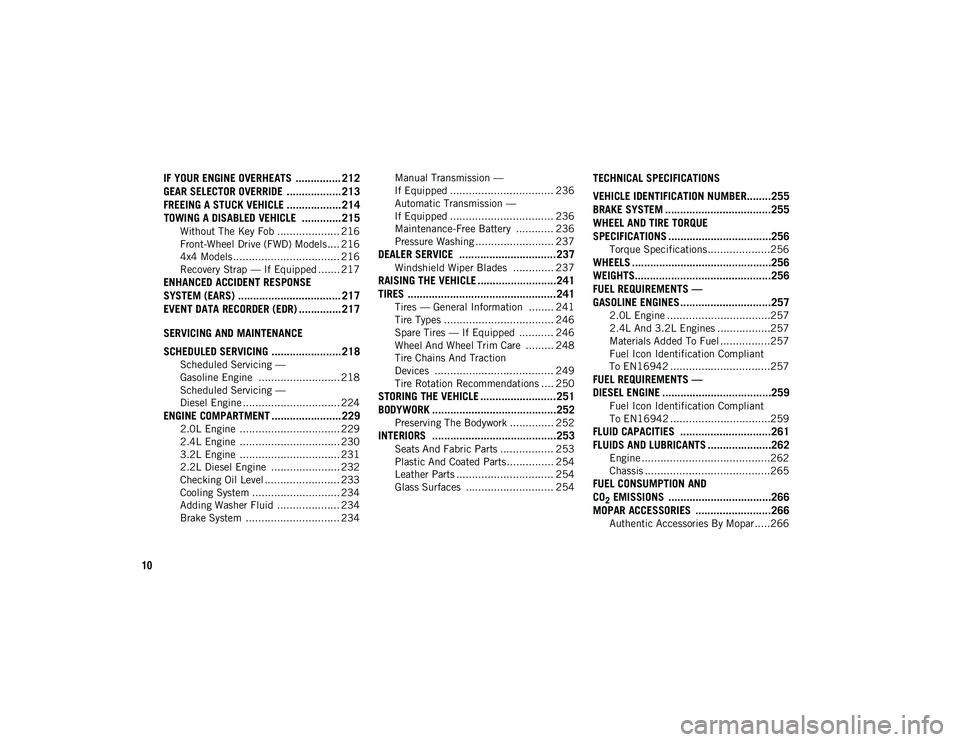
10
IF YOUR ENGINE OVERHEATS ............... 212
GEAR SELECTOR OVERRIDE .................. 213FREEING A STUCK VEHICLE .................. 214TOWING A DISABLED VEHICLE ............. 215
Without The Key Fob .................... 216
Front-Wheel Drive (FWD) Models .... 216
4x4 Models .................................. 216
Recovery Strap — If Equipped ....... 217
ENHANCED ACCIDENT RESPONSE
SYSTEM (EARS) .................................. 217
EVENT DATA RECORDER (EDR) .............. 217
SERVICING AND MAINTENANCE
SCHEDULED SERVICING ....................... 218
Scheduled Servicing —
Gasoline Engine .......................... 218 Scheduled Servicing —
Diesel Engine ............................... 224
ENGINE COMPARTMENT ....................... 229
2.0L Engine ................................ 229
2.4L Engine ................................ 230
3.2L Engine ................................ 231
2.2L Diesel Engine ...................... 232
Checking Oil Level ........................ 233
Cooling System ............................ 234
Adding Washer Fluid .................... 234
Brake System .............................. 234 Manual Transmission —
If Equipped ................................. 236 Automatic Transmission —
If Equipped ................................. 236 Maintenance-Free Battery ............ 236
Pressure Washing ......................... 237
DEALER SERVICE ................................237
Windshield Wiper Blades ............. 237
RAISING THE VEHICLE ..........................241
TIRES .................................................241
Tires — General Information ........ 241
Tire Types ................................... 246
Spare Tires — If Equipped ........... 246
Wheel And Wheel Trim Care ......... 248
Tire Chains And Traction
Devices ...................................... 249 Tire Rotation Recommendations .... 250
STORING THE VEHICLE .........................251BODYWORK .........................................252
Preserving The Bodywork .............. 252
INTERIORS .........................................253
Seats And Fabric Parts ................. 253
Plastic And Coated Parts............... 254
Leather Parts ............................... 254
Glass Surfaces ............................ 254
TECHNICAL SPECIFICATIONS
VEHICLE IDENTIFICATION NUMBER........255BRAKE SYSTEM ...................................255
WHEEL AND TIRE TORQUE
SPECIFICATIONS ..................................256
Torque Specifications ....................256
WHEELS ..............................................256
WEIGHTS.............................................256
FUEL REQUIREMENTS —
GASOLINE ENGINES ..............................257
2.0L Engine .................................257
2.4L And 3.2L Engines .................257
Materials Added To Fuel ................257
Fuel Icon Identification Compliant
To EN16942 ................................257
FUEL REQUIREMENTS —
DIESEL ENGINE ....................................259
Fuel Icon Identification Compliant
To EN16942 ................................259
FLUID CAPACITIES ..............................261
FLUIDS AND LUBRICANTS .....................262
Engine .........................................262
Chassis ........................................265
FUEL CONSUMPTION AND
CO
2 EMISSIONS ..................................266
MOPAR ACCESSORIES .........................266
Authentic Accessories By Mopar .....266
2020_JEEP_CHEROKEE_UG_RHD_UK.book Page 10
Page 62 of 332
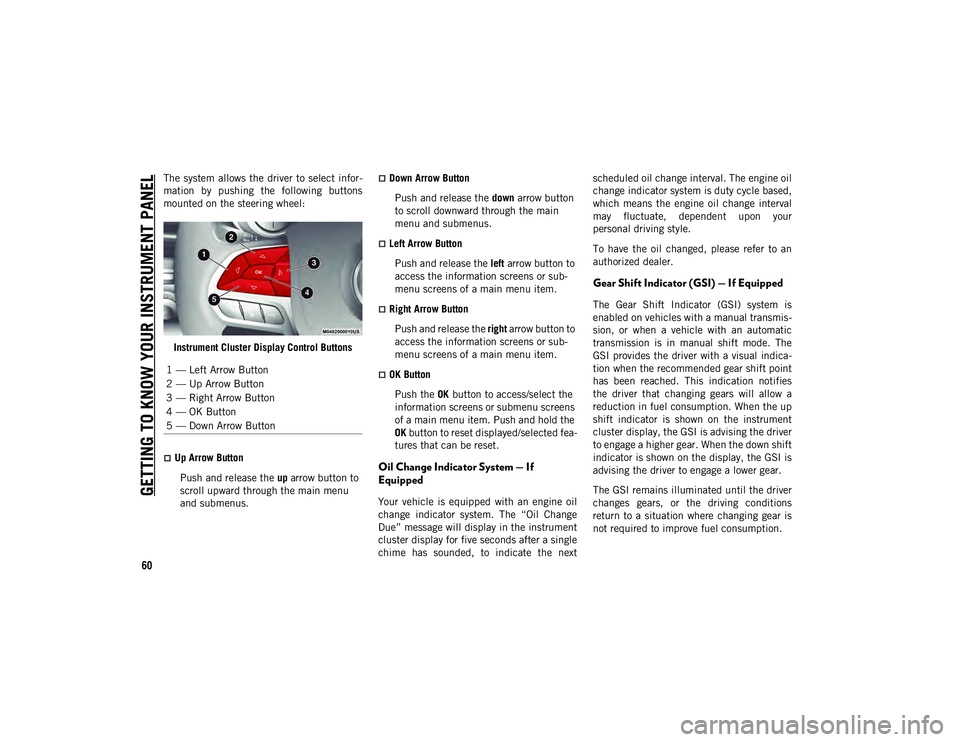
GETTING TO KNOW YOUR INSTRUMENT PANEL
60
The system allows the driver to select infor-
mation by pushing the following buttons
mounted on the steering wheel:
Instrument Cluster Display Control Buttons
Up Arrow ButtonPush and release the up arrow button to
scroll upward through the main menu
and submenus.
Down Arrow Button
Push and release the down arrow button
to scroll downward through the main
menu and submenus.
Left Arrow Button
Push and release the left arrow button to
access the information screens or sub -
menu screens of a main menu item.
Right Arrow Button
Push and release the right arrow button to
access the information screens or sub -
menu screens of a main menu item.
OK Button
Push the OK button to access/select the
information screens or submenu screens
of a main menu item. Push and hold the
OK button to reset displayed/selected fea -
tures that can be reset.
Oil Change Indicator System — If
Equipped
Your vehicle is equipped with an engine oil
change indicator system. The “Oil Change
Due” message will display in the instrument
cluster display for five seconds after a single
chime has sounded, to indicate the next scheduled oil change interval. The engine oil
change indicator system is duty cycle based,
which means the engine oil change interval
may fluctuate, dependent upon your
personal driving style.
To have the oil changed, please refer to an
authorized dealer.
Gear Shift Indicator (GSI) — If Equipped
The Gear Shift Indicator (GSI) system is
enabled on vehicles with a manual transmis
-
sion, or when a vehicle with an automatic
transmission is in manual shift mode. The
GSI provides the driver with a visual indica -
tion when the recommended gear shift point
has been reached. This indication notifies
the driver that changing gears will allow a
reduction in fuel consumption. When the up
shift indicator is shown on the instrument
cluster display, the GSI is advising the driver
to engage a higher gear. When the down shift
indicator is shown on the display, the GSI is
advising the driver to engage a lower gear.
The GSI remains illuminated until the driver
changes gears, or the driving conditions
return to a situation where changing gear is
not required to improve fuel consumption.
1 — Left Arrow Button
2 — Up Arrow Button
3 — Right Arrow Button
4 — OK Button
5 — Down Arrow Button
2020_JEEP_CHEROKEE_UG_RHD_UK.book Page 60
Page 64 of 332
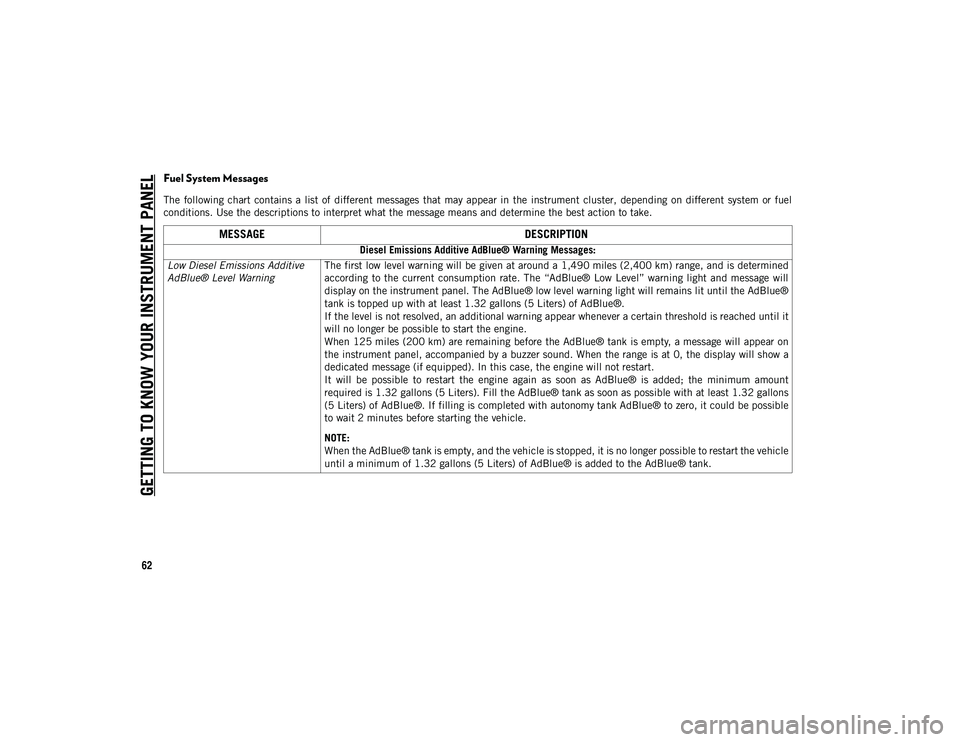
GETTING TO KNOW YOUR INSTRUMENT PANEL
62
Fuel System Messages
The following chart contains a list of different messages that may appear in the instrument cluster, depending on different system or fuel
conditions. Use the descriptions to interpret what the message means and determine the best action to take.
MESSAGEDESCRIPTION
Diesel Emissions Additive AdBlue® Warning Messages:
Low Diesel Emissions Additive
AdBlue® Level Warning The first low level warning will be given at around a 1,490 miles (2,400 km) range, and is determined
according to the current consumption rate. The “AdBlue® Low Level” warning light and message will
display on the instrument panel. The AdBlue® low level warning light will remains lit until the AdBlue®
tank is topped up with at least 1.32 gallons (5 Liters) of AdBlue®.
If the level is not resolved, an additional warning appear whenever a certain threshold is reached until it
will no longer be possible to start the engine.
When 125 miles (200 km) are remaining before the AdBlue® tank is empty, a message will appear on
the instrument panel, accompanied by a buzzer sound. When the range is at 0, the display will show a
dedicated message (if equipped). In this case, the engine will not restart.
It will be possible to restart the engine again as soon as AdBlue® is added; the minimum amount
required is 1.32 gallons (5 Liters). Fill the AdBlue® tank as soon as possible with at least 1.32 gallons
(5 Liters) of AdBlue®. If filling is completed with autonomy tank AdBlue® to zero, it could be possible
to wait 2 minutes before starting the vehicle.
NOTE:
When the AdBlue® tank is empty, and the vehicle is stopped, it is no longer possible to restart the vehicle
until a minimum of 1.32 gallons (5 Liters) of AdBlue® is added to the AdBlue® tank.
2020_JEEP_CHEROKEE_UG_RHD_UK.book Page 62
Page 71 of 332
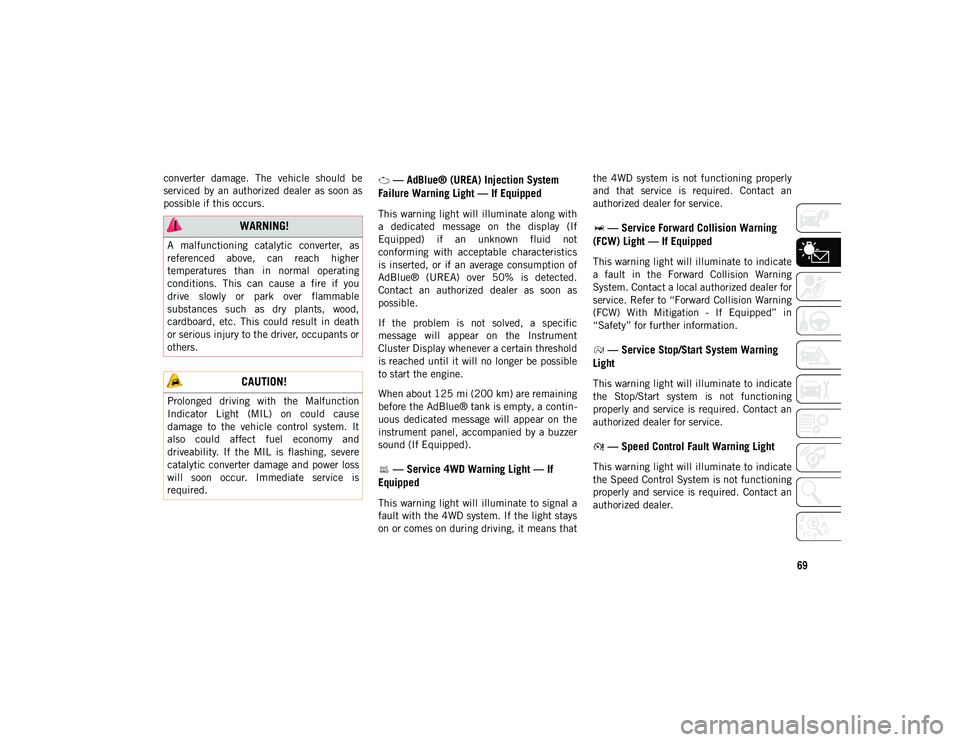
69
converter damage. The vehicle should be
serviced by an authorized dealer as soon as
possible if this occurs. — AdBlue® (UREA) Injection System
Failure Warning Light — If Equipped
This warning light will illuminate along with
a dedicated message on the display (If
Equipped) if an unknown fluid not
conforming with acceptable characteristics
is inserted, or if an average consumption of
AdBlue® (UREA) over 50% is detected.
Contact an authorized dealer as soon as
possible.
If the problem is not solved, a specific
message will appear on the Instrument
Cluster Display whenever a certain threshold
is reached until it will no longer be possible
to start the engine.
When about 125 mi (200 km) are remaining
before the AdBlue® tank is empty, a contin -
uous dedicated message will appear on the
instrument panel, accompanied by a buzzer
sound (If Equipped).
— Service 4WD Warning Light — If
Equipped
This warning light will illuminate to signal a
fault with the 4WD system. If the light stays
on or comes on during driving, it means that the 4WD system is not functioning properly
and that service is required. Contact an
authorized dealer for service.
— Service Forward Collision Warning
(FCW) Light — If Equipped
This warning light will illuminate to indicate
a fault in the Forward Collision Warning
System. Contact a local authorized dealer for
service. Refer to “Forward Collision Warning
(FCW) With Mitigation - If Equipped” in
“Safety” for further information.
— Service Stop/Start System Warning
Light
This warning light will illuminate to indicate
the Stop/Start system is not functioning
properly and service is required. Contact an
authorized dealer for service.
— Speed Control Fault Warning Light
This warning light will illuminate to indicate
the Speed Control System is not functioning
properly and service is required. Contact an
authorized dealer.
WARNING!
A malfunctioning catalytic converter, as
referenced above, can reach higher
temperatures than in normal operating
conditions. This can cause a fire if you
drive slowly or park over flammable
substances such as dry plants, wood,
cardboard, etc. This could result in death
or serious injury to the driver, occupants or
others.
CAUTION!
Prolonged driving with the Malfunction
Indicator Light (MIL) on could cause
damage to the vehicle control system. It
also could affect fuel economy and
driveability. If the MIL is flashing, severe
catalytic converter damage and power loss
will soon occur. Immediate service is
required.
2020_JEEP_CHEROKEE_UG_RHD_UK.book Page 69
Page 72 of 332
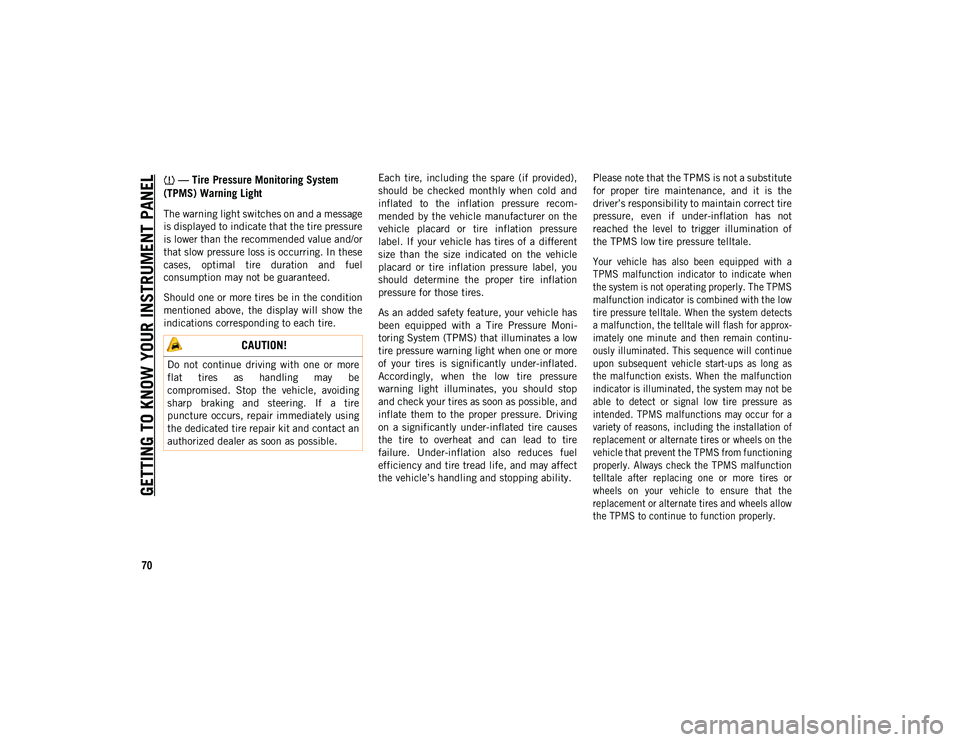
GETTING TO KNOW YOUR INSTRUMENT PANEL
70
— Tire Pressure Monitoring System
(TPMS) Warning Light
The warning light switches on and a message
is displayed to indicate that the tire pressure
is lower than the recommended value and/or
that slow pressure loss is occurring. In these
cases, optimal tire duration and fuel
consumption may not be guaranteed.
Should one or more tires be in the condition
mentioned above, the display will show the
indications corresponding to each tire. Each tire, including the spare (if provided),
should be checked monthly when cold and
inflated to the inflation pressure recom
-
mended by the vehicle manufacturer on the
vehicle placard or tire inflation pressure
label. If your vehicle has tires of a different
size than the size indicated on the vehicle
placard or tire inflation pressure label, you
should determine the proper tire inflation
pressure for those tires.
As an added safety feature, your vehicle has
been equipped with a Tire Pressure Moni -
toring System (TPMS) that illuminates a low
tire pressure warning light when one or more
of your tires is significantly under-inflated.
Accordingly, when the low tire pressure
warning light illuminates, you should stop
and check your tires as soon as possible, and
inflate them to the proper pressure. Driving
on a significantly under-inflated tire causes
the tire to overheat and can lead to tire
failure. Under-inflation also reduces fuel
efficiency and tire tread life, and may affect
the vehicle’s handling and stopping ability. Please note that the TPMS is not a substitute
for proper tire maintenance, and it is the
driver’s responsibility to maintain correct tire
pressure, even if under-inflation has not
reached the level to trigger illumination of
the TPMS low tire pressure telltale.
Your vehicle has also been equipped with a
TPMS malfunction indicator to indicate when
the system is not operating properly. The TPMS
malfunction indicator is combined with the low
tire pressure telltale. When the system detects
a malfunction, the telltale will flash for approx
-
imately one minute and then remain continu -
ously illuminated. This sequence will continue
upon subsequent vehicle start-ups as long as
the malfunction exists. When the malfunction
indicator is illuminated, the system may not be
able to detect or signal low tire pressure as
intended. TPMS malfunctions may occur for a
variety of reasons, including the installation of
replacement or alternate tires or wheels on the
vehicle that prevent the TPMS from functioning
properly. Always check the TPMS malfunction
telltale after replacing one or more tires or
wheels on your vehicle to ensure that the
replacement or alternate tires and wheels allow
the TPMS to continue to function properly.
CAUTION!
Do not continue driving with one or more
flat tires as handling may be
compromised. Stop the vehicle, avoiding
sharp braking and steering. If a tire
puncture occurs, repair immediately using
the dedicated tire repair kit and contact an
authorized dealer as soon as possible.
2020_JEEP_CHEROKEE_UG_RHD_UK.book Page 70
Page 156 of 332
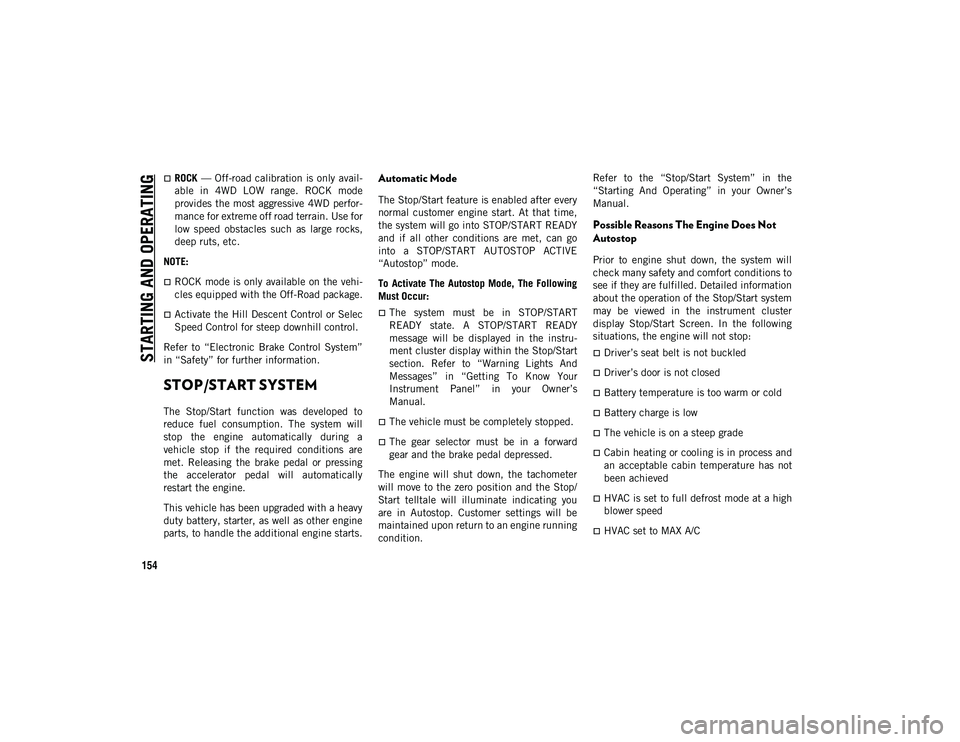
STARTING AND OPERATING
154
ROCK — Off-road calibration is only avail -
able in 4WD LOW range. ROCK mode
provides the most aggressive 4WD perfor -
mance for extreme off road terrain. Use for
low speed obstacles such as large rocks,
deep ruts, etc.
NOTE:
ROCK mode is only available on the vehi -
cles equipped with the Off-Road package.
Activate the Hill Descent Control or Selec
Speed Control for steep downhill control.
Refer to “Electronic Brake Control System”
in “Safety” for further information.
STOP/START SYSTEM
The Stop/Start function was developed to
reduce fuel consumption. The system will
stop the engine automatically during a
vehicle stop if the required conditions are
met. Releasing the brake pedal or pressing
the accelerator pedal will automatically
restart the engine.
This vehicle has been upgraded with a heavy
duty battery, starter, as well as other engine
parts, to handle the additional engine starts.
Automatic Mode
The Stop/Start feature is enabled after every
normal customer engine start. At that time,
the system will go into STOP/START READY
and if all other conditions are met, can go
into a STOP/START AUTOSTOP ACTIVE
“Autostop” mode.
To Activate The Autostop Mode, The Following
Must Occur:
The system must be in STOP/START
READY state. A STOP/START READY
message will be displayed in the instru -
ment cluster display within the Stop/Start
section. Refer to “Warning Lights And
Messages” in “Getting To Know Your
Instrument Panel” in your Owner’s
Manual.
The vehicle must be completely stopped.
The gear selector must be in a forward
gear and the brake pedal depressed.
The engine will shut down, the tachometer
will move to the zero position and the Stop/
Start telltale will illuminate indicating you
are in Autostop. Customer settings will be
maintained upon return to an engine running
condition. Refer to the “Stop/Start System” in the
“Starting And Operating” in your Owner’s
Manual.
Possible Reasons The Engine Does Not
Autostop
Prior to engine shut down, the system will
check many safety and comfort conditions to
see if they are fulfilled. Detailed information
about the operation of the Stop/Start system
may be viewed in the instrument cluster
display Stop/Start Screen. In the following
situations, the engine will not stop:
Driver’s seat belt is not buckled
Driver’s door is not closed
Battery temperature is too warm or cold
Battery charge is low
The vehicle is on a steep grade
Cabin heating or cooling is in process and
an acceptable cabin temperature has not
been achieved
HVAC is set to full defrost mode at a high
blower speed
HVAC set to MAX A/C
2020_JEEP_CHEROKEE_UG_RHD_UK.book Page 154
Page 264 of 332
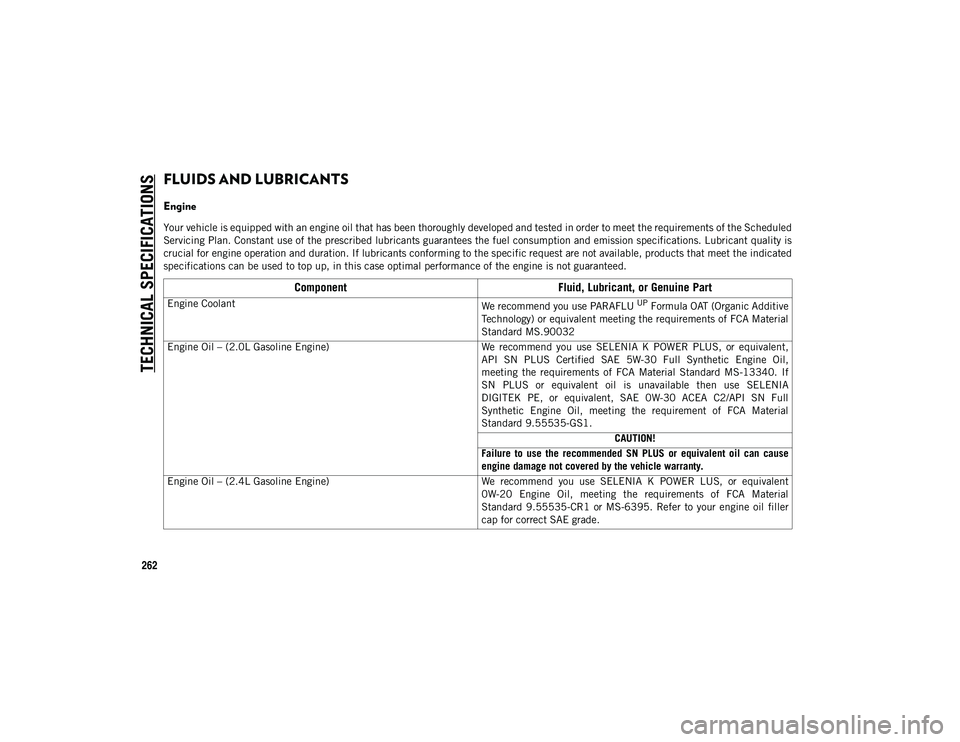
TECHNICAL SPECIFICATIONS
262
FLUIDS AND LUBRICANTS
Engine
Your vehicle is equipped with an engine oil that has been thoroughly developed and tested in order to meet the requirements of the Scheduled
Servicing Plan. Constant use of the prescribed lubricants guarantees the fuel consumption and emission specifications. Lubricant quality is
crucial for engine operation and duration. If lubricants conforming to the specific request are not available, products that meet the indicated
specifications can be used to top up, in this case optimal performance of the engine is not guaranteed.
ComponentFluid, Lubricant, or Genuine Part
Engine Coolant
We recommend you use PARAFLU UP Formula OAT (Organic Additive
Technology) or equivalent meeting the requirements of FCA Material
Standard MS.90032
Engine Oil – (2.0L Gasoline Engine) We recommend you use SELENIA K POWER PLUS, or equivalent,
API SN PLUS Certified SAE 5W-30 Full Synthetic Engine Oil,
meeting the requirements of FCA Material Standard MS-13340. If
SN PLUS or equivalent oil is unavailable then use SELENIA
DIGITEK PE, or equivalent, SAE 0W-30 ACEA C2/API SN Full
Synthetic Engine Oil, meeting the requirement of FCA Material
Standard 9.55535-GS1.
CAUTION!
Failure to use the recommended SN PLUS or equivalent oil can cause
engine damage not covered by the vehicle warranty.
Engine Oil – (2.4L Gasoline Engine) We recommend you use SELENIA K POWER LUS, or equivalent
0W-20 Engine Oil, meeting the requirements of FCA Material
Standard 9.55535-CR1 or MS-6395. Refer to your engine oil filler
cap for correct SAE grade.
2020_JEEP_CHEROKEE_UG_RHD_UK.book Page 262
Page 268 of 332
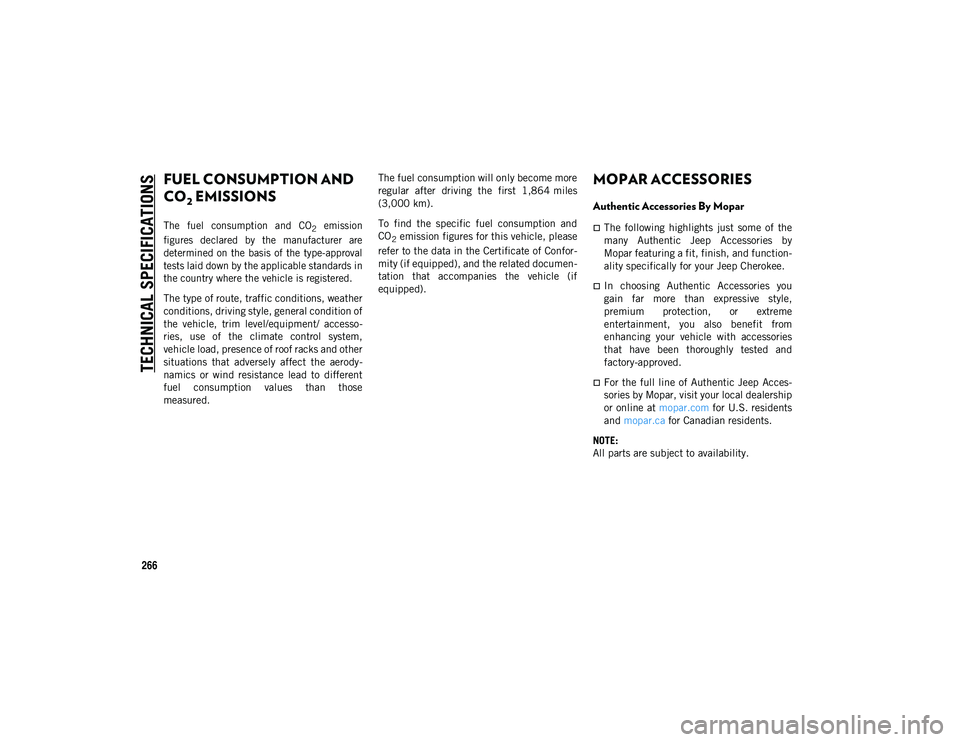
TECHNICAL SPECIFICATIONS
266
FUEL CONSUMPTION AND
CO
2 EMISSIONS
The fuel consumption and CO2 emission
figures declared by the manufacturer are
determined on the basis of the type-approval
tests laid down by the applicable standards in
the country where the vehicle is registered.
The type of route, traffic conditions, weather
conditions, driving style, general condition of
the vehicle, trim level/equipment/ accesso -
ries, use of the climate control system,
vehicle load, presence of roof racks and other
situations that adversely affect the aerody -
namics or wind resistance lead to different
fuel consumption values than those
measured. The fuel consumption will only become more
regular after driving the first 1,864 miles
(3,000 km).
To find the specific fuel consumption and
CO
2 emission figures for this vehicle, please
refer to the data in the Certificate of Confor -
mity (if equipped), and the related documen -
tation that accompanies the vehicle (if
equipped).
MOPAR ACCESSORIES
Authentic Accessories By Mopar
The following highlights just some of the
many Authentic Jeep Accessories by
Mopar featuring a fit, finish, and function -
ality specifically for your Jeep Cherokee.
In choosing Authentic Accessories you
gain far more than expressive style,
premium protection, or extreme
entertainment, you also benefit from
enhancing your vehicle with accessories
that have been thoroughly tested and
factory-approved.
For the full line of Authentic Jeep Acces-
sories by Mopar, visit your local dealership
or online at mopar.com for U.S. residents
and mopar.ca for Canadian residents.
NOTE:
All parts are subject to availability.
2020_JEEP_CHEROKEE_UG_RHD_UK.book Page 266
Page 326 of 332
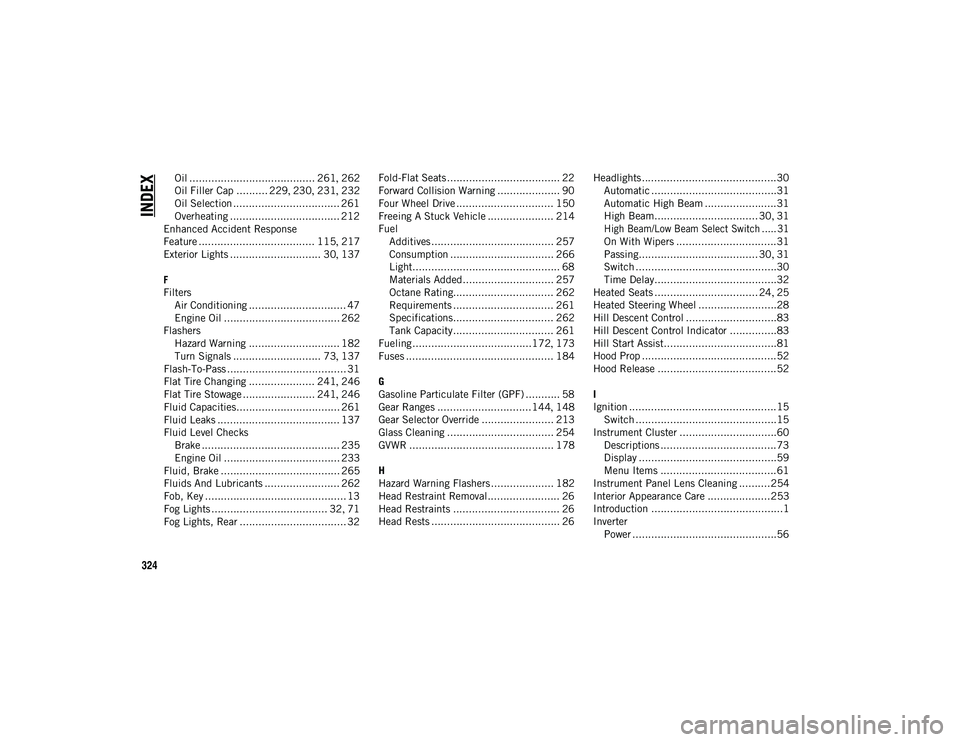
324
INDEX
Oil ........................................ 261, 262
Oil Filler Cap .......... 229 , 230 , 231 , 232
Oil Selection .................................. 261
Overheating ................................... 212
Enhanced Accident Response
Feature ..................................... 115 , 217
Exterior Lights ............................. 30 , 137
F
Filters Air Conditioning ............................... 47
Engine Oil ..................................... 262
Flashers Hazard Warning ............................. 182Turn Signals ............................ 73 , 137
Flash-To-Pass ...................................... 31
Flat Tire Changing ..................... 241 , 246
Flat Tire Stowage ....................... 241 , 246
Fluid Capacities................................. 261
Fluid Leaks ....................................... 137
Fluid Level Checks Brake ............................................ 235
Engine Oil ..................................... 233
Fluid, Brake ...................................... 265
Fluids And Lubricants ........................ 262
Fob, Key ............................................. 13
Fog Lights ..................................... 32 , 71
Fog Lights, Rear .................................. 32 Fold-Flat Seats .................................... 22
Forward Collision Warning .................... 90
Four Wheel Drive ............................... 150
Freeing A Stuck Vehicle ..................... 214
Fuel
Additives ....................................... 257
Consumption ................................. 266
Light............................................... 68
Materials Added............................. 257
Octane Rating................................ 262
Requirements ................................ 261
Specifications................................ 262
Tank Capacity................................ 261
Fueling ......................................172 , 173
Fuses ............................................... 184
G
Gasoline Particulate Filter (GPF) ........... 58
Gear Ranges ..............................144 , 148
Gear Selector Override ....................... 213
Glass Cleaning .................................. 254
GVWR .............................................. 178
H
Hazard Warning Flashers .................... 182
Head Restraint Removal ....................... 26
Head Restraints .................................. 26
Head Rests ......................................... 26 Headlights ...........................................30
Automatic ........................................31
Automatic High Beam .......................31
High Beam................................. 30 , 31
High Beam/Low Beam Select Switch ..... 31
On With Wipers ................................31
Passing...................................... 30 , 31
Switch .............................................30 Time Delay.......................................32
Heated Seats ................................. 24 , 25
Heated Steering Wheel .........................28
Hill Descent Control .............................83
Hill Descent Control Indicator ...............83
Hill Start Assist....................................81
Hood Prop ...........................................52
Hood Release ......................................52
I
Ignition ...............................................15 Switch .............................................15
Instrument Cluster ...............................60 Descriptions .....................................73
Display ............................................59Menu Items .....................................61
Instrument Panel Lens Cleaning ..........254
Interior Appearance Care ....................253
Introduction ..........................................1
Inverter Power ..............................................56
2020_JEEP_CHEROKEE_UG_RHD_UK.book Page 324